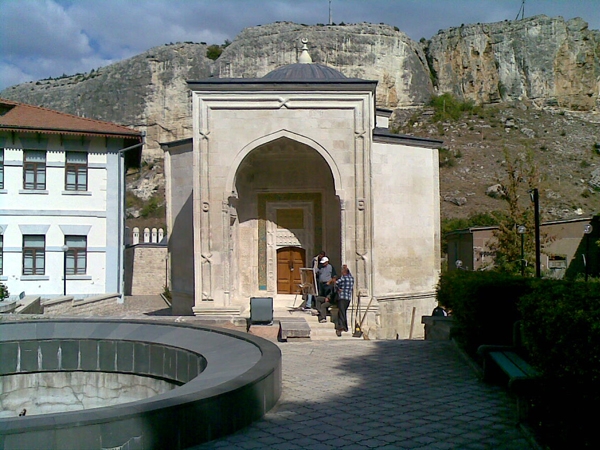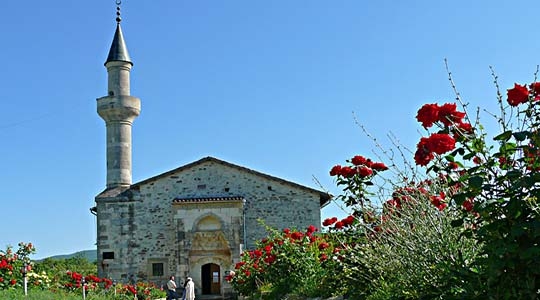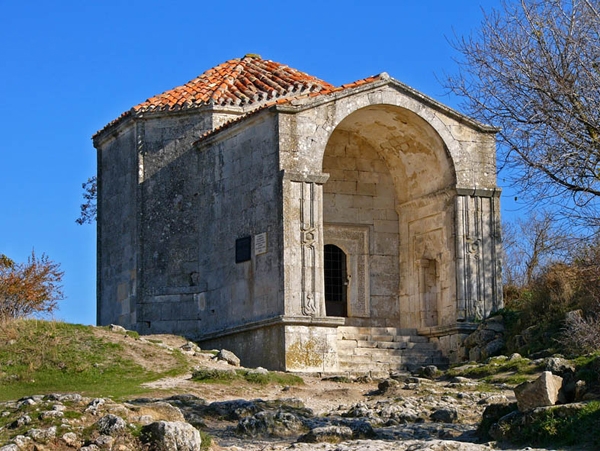The legend has it that Islam proliferated in Crimea owing to two associates of Prophet Muhammad Malik al-Ashtar and Ghazi Mansour as early as the 7th century A.D. Yet it is more likely that the peninsula turned Muslim owing to Turks rather than Arabs. It came as a result of a conquest in the 13th century. In 1222 Sudak and Solkhat (now Staryi Krym or Old Crimea) were temporarily held by the Seljuks under the leadership of Amir Husain-ad-din Choban, the military chief of the famous Seljuk sultan Alaeddin Keykubad I. After one year they were displaced by the Mongols led by Genghis Khan's eldest son Jochi. They ruled Crimea for the two following centuries. The first Golden Horde leader to adopt Islam was Berke Khan, Batu's brother. This ruler did not carry out forced islamisation of the population, which at the time included Tengriists, Christians and Judaists among others. At the same time khan's documents contain mentions of "Sheiks and Sufis" next to officials and ruling classes of the khanate. The oldest mosque on the peninsula was built in 1262 in Solkhat by a Bukhara native. But oldest remaining ruins are of the mosque complex commissioned directly by the Mamluk Sultan Baibars in 1288. After 1475 when the Ottoman Turks captured Caffa the Crimean peninsula fell under the influence of the Turkish Islam with all of its implications. That is when the Hanafi Sunni Islam (one of the four main Islamic schools of jurisprudence) was proclaimed the official religion of the Crimean Khanate, while the Turkish Padishah became the caliph of all Sunnis. This period saw the formation of the unique Turkic-Muslim culture, which had a considerable influence on Crimea and the adjacent territories up until 1917.
The Mongol and Ottoman empires, as well as the Crimean Khanate within them appear to be rather diverse countries in terms of ethnicity and religion, countries, the rulers of which were devoid of religious fanaticism. Even proclaiming Sunni Islam as the official religion of the state they did not carry out sweeping systemic Islamisation of the followers of other religions populating the land, they realized that religious conflicts would only weaken the state. It's worth noting that in the case of the Crimean Khanate the process of adopting Islam was not completed until the 18th century. 'In the context of converting the story of the Crimean Greek population, which was deported by Catherine II to what is currently the south of Donetsk region, is very telling. Among them were the Turkic Urums, whose language is in many ways closer to the Crimean Tatar one, rather than other Turkic languages. In order to avoid deportation entire villages converted to Islam. Turkic-speaking Muslim equaled Crimean Tatar, and the latter weren't subject to deportation. So entire villages on the South Coast of Crimea, which had been Christian for centuries became Muslim. Many of the current residents in those parts believe they are Crimean Tatars, although in reality they have Greek roots', says the Crimean Tatar independent journalist Dilaver Saidakhmetov. Seiran Afirov, who used to be mufti of a Simferopol mosque before Crimea's annexation adds: 'In the Ottoman Empire those, who converted from Islam to other religions were punished only if they partook in military campaigns against Porte. In such a case they were accused not of apostasy, but of treason. In all other cases there were attempts to persuade such persons to turn back to Islam in a peaceful manner.'
Crimea of madrassas and Sufis
The Crimean peninsula had always been not on the outskirts of the Muslim world, but rather one of its cultural and education centers, at the crossroads of the pathways from countries in the Middle East and Central Asia, of Turkey and Persia, which allowed acquiring and accumulating knowledge, and having own input both in theology and law, as well as in science. Unfortunately, not many in today's Ukraine know about this. Orientalist Mykhaylo Yakubovych notes: “The Crimean Khanate is the territory from the Dnipro's rapids to Crimea, Azov and so forth. It has cultural likeness to Yedysan – the lands between the Dniester and the Bug, and Budjak — the lands between the Danube and the Dniester, which is the Northern Black Sea cultural region'. According to Yakubovych, among the world famous ulamas, judges, scientists, philosophers were the natives of this region, known as Caffavi (of Caffa), Qirimi or Karayimi, Akkermani etc. There were also names like al-Deshti (for example Ibrahim al-Meghmed al-Dashti Tatarsheikh), so those were the natives from what is currently the territory of Zaporizhzhia and Kherson regions. The orientalist underscores that the residents of Crimea made a substantial contribution in the three main domains of the Muslim culture. 'The matter of traditional Islamic Hanafi law has been developed by many authors, beginning with Sharafaddin al-Qirimi in the 15th century, and all the way to Addousadar al-Qirimi, the author of commentary to "Medjele" (the code of Ottoman law)”, — the scholar continues. “The other element is kalam, the Islamic speculative theology. There was a whole cluster of Crimean authors, including Abu l'Baka al-Caffavi, the son of Caffa's mufti, who wrote "Kitab al-Kulliyat" ("Book of general notions"), an enormous work in Arabic containing 3,000 definitions. Their version of Denis Diderot, if you like. In the 18th century there were such authors as Mughammad al-Akkermani and Mughammad al-Caffavi. These two belong to Calizadeliph, the reformation movement in Islamic theology, which stood for modernization and the return to Sunna.”
The Crimean Tatars' contribution to Sufism deserves a separate mention. Up until 1917 there were active spiritual centers representing four Sufi schools: Naqshbandi, Khalwati, Qadri and Mevlevi. The Naqshbandi and Khalwati representatives had the biggest presence and made the greatest intellectual contribution. “Out of the former it is worth mentioning Abd al-Baki Hijabi, the creator of "Risale Zubdet ul-Islam", written in Ottoman language; out of the former — the 15th century author Aghmad al-Qirimi, the proponent of ibn-Arabi views on equality of being, who substantiated a philosophical ontology” — Mykhaylo Yakubovych states. Ibrahim al-Qirimi was a unique Khalwati thinker, the author of "Mawahib, ar-rahman fi-bayan maratib al-ikhwan" ("Gifts of the Merciful in Understanding of the Stages of Being") dedicated to the Ottoman sultan Mourad III, with a range of illustrations. One should also mention the representatives of the Qadri tariqate, particularly Selima Divane Qirimli, the 18th century Ottoman language author from Skopje, who wrote the well-known "Burhan-ul-Arifin we Nejatu al-Ghafilin" ("Guidance for the Knowing and Salvation of the Oblivious"). Who knows, perhaps it were these Sufis, who gave the present-day Crimean Tatars the tradition of honoring the aziz sites (important burial grounds of scientists, dervishes, military, who were made into saints by storytelling and the passing of time).
Crimea had its Islamic universities, the madrasas. Zincirli Madrasa is the famous one, but there were more. In 1332 with the support of Uzbek Khan emerged one of the first Muslim higher education schools of the peninsula – the Indji-bek Khatun Madrasa. Its first teachers were scientists from Persia and Central Asia. In the 15-16th centuries emerged the first generation of native Crimean Tatar scientists. They seek opportunities to move to other Muslim education centers overseas, in particular to Istanbul. According to Mykhayko Yakubovych, this speaks not of their parochial nature, but on the contrary, of active cultural exchange, which deserves deeper research.
The roots of moderation
Many wonder how come the Islam embraced by the Crimean Tatars — one of Ukraine's indigenous peoples — did not become radical in the present circumstances. There are a number of reasons. First and foremost it is the manifestation of the Turkic Islamic tradition described above. Another reason is that for more than two centuries Islam for the Crimean Tatars has been a private matter, not a social or political one. Ever since Crimea was annexed by the Russian Empire in 1784, Crimean Tatars were devoid of statehood and their religion no longer served as an instrument of politics. Therefore, as both mufti Seiran Afirov and the orientalist Mykhaylo Yakubovych describe it, all Islamic processes took place in non-Islamic context. “The Volga and the Crimean Tatars are ethnicities who underwent modernization in non-Islamic environment. That is why the ideologies of political Islam that are characteristic of some Arabic states, aren't viewed as adequate by the Crimean Tatars. The Hanafi tradition got isolated within non-Islamic environment,” – the scholar says. That is why the Crimean Islam is a European one, to a great extent a cultural one. The ideas of the ISIS and caliphate for this very reason are seen by them as something far-out.
According to Seiran Afirov, the formation of moderate Islam took place not without interference by the Soviet regime, as the representatives of this ethnic group got forcibly relocated to Central Asia. “In 1917 during the national liberation struggle, which was suppressed by the Bolsheviks, the Crimean Tatars lost the majority of their cultural elite, in which ulamas, imams and qadis (Muslim judges) played a significant role. Religious literature was destroyed, madrasas and mosques were closed. The number of people able to read religious literature written in old Crimean Tatar language using Arabic script was declining. As a consequence in a few decades Muslims in Crimea lost their respective knowledge and skills, while new religious books were in short supply. Basically, from 1917 to practically the late 1980s we had virtually no Islam at all. It was only preserved in the memory and the practices followed by the regular people,” states the imam.
The latter is something that every Crimean Tatar person can tell you all about recalling the customs of his family. Sunnet (circumcision), nikah (marriage), talaq (divorce) janazah (funeral), the ban on consuming pork… And that's about it. Nikah had been followed during the Soviet era rather as a tribute to tradition, as the anti-religion state policy has a significant impact. Extremely significant were the representatives of the clergy, who still remembered at least the basics of the Islamic teaching passing it them from one to another or from older relatives, who were also imams. Seiran Afirov recalls that in Central Asia the Crimean Tatars made an effort to stand out of the local community, which was also Turkic, in order to avoid assimilation. 'Most of the religious rites were conducted by Crimean mullahs. Only in times of large holidays like Sawm or Kurban Bayram (Eid al-Adha) the Crimean Tatars would join the local Muslims, where Uzbek or Kazakh imams headed the proceedings.' Generally Afirov describes the religious situation of the Crimean Tatars up until 1989 as something resembling complete vacuum imposed by the Soviet authorities, an information vacuum, which could be filled with fables and superstition. Someone had to counter this with adequate religious knowledge.
Ukraine's independence gave the Crimean Tatars the opportunity to return home and a chance to restore Islamic faith on the peninsula. The religious crisis, which span over 50 years had to be overcome somehow, to study religion all over again using different sources, of which there were several, particularly Turkic and Arabic. Already in the early 1990s the Muslims of Turkey established contact with Crimea's first mufti Seitdjelil Ibrahimov and the Crimean muftiate. They opened a number of madrasas, sent literature and welcomed the graduates of Crimean madrasas for advanced studies (Crimean madrasas used to provide only a 1-2 year primary course). Owing to the Turks the Crimean Tatars received access to ilahiyat (Muslim faculties) in various Turkish universities. The Turkish influence included those who brought a variety of minute details of Turkish Islamic tradition to Crimea. As far as ideology is concerned, those belong to moderate Islam. There were, however, rather rigid Sufis, who were adamant that only their views were true. The followers of Fethullah Gülen, a branch of the Risale-I Nur Movement, presented another separate line.
The other source was Arabic. In 1990s students from Arabic countries began coming to Crimea in order to work with the locals. They toured the villages, conducted one- or two-week long courses, as well as Sunday classes to get the locals acquainted with Islam. While they were not Muslim scholars, each of them possessed religious knowledge far deeper than the majority of the Crimean Tatar mullahs could boast. In terms of interpretation of Islam, the Arabic world is not homogenous either. Some belong to moderate movements, some to Salafist, "Hizb ut-Tahrir", Al-Ahbash etc. As a result, Islam on the Crimean peninsula is in a way a projection of the modern Islamic world, where different movements balance each other out, not allowing any one of them to dominate.
Source: The Ukrainian Week





